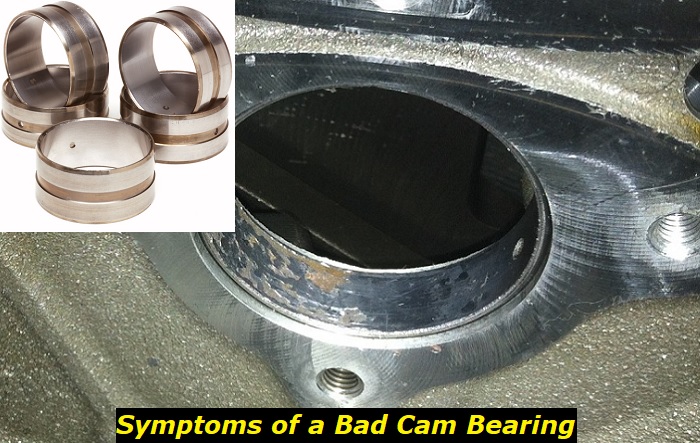Your car generates a lot of power. It does this through the interaction of many different parts. One of the core parts is the valve train, and the heart of the valve train is the camshaft, which directly bears the brunt of the power produced by the engine. The camshaft must be supported and lubricated by the cam bearings, which are designed to handle these stresses.
Engine bearing problems highlights
- Level of importance:High
- Commonreasons:Overheating, low oil pressure
- DIY inspection:Almost impossible
- DIY repair:Impossible
- Price for repair:$1,000 - $3,500
- Can you drive?Usually, no
- Ways to fix:Engine will need complete overhaul if rod bearings are dead

What Causes Cam Bearings to Fail
Cam bearings don't just fail out of nowhere. Under the right conditions, these bearings are designed to last for a very long time. Of course, that doesn't mean you'll never end up with cam issues. If you're wondering about the source of that strange sound under the hood.
- Misaligned Camshaft
The bearings are designed to hold the camshaft tightly in place while allowing it to rotate freely. That's why they have very strict clearances and allowances. If the camshaft is aligned even slightly wrong, it can result in unwanted friction that wears away at cam bearings. This friction also causes heat that further damages the bearings.
- Oil Starvation
Contact between the bearings and the camshaft is inevitable. The cam bearings are specifically designed to withstand the stresses of their operating environment, but they won't last long at all without proper lubrication. Most cam failures are caused by a lack of lubrication between the cam bearings and the camshaft.
Oil starvation results in extreme friction and heat that the bearings cannot withstand. This causes pitting and flaking of the bearing lining material.
- Contaminated oil
The allowance between the bearings and the camshaft is so small that even tiny specks of solid particles and debris can result in damage. If dirt, metal shavings, sand, or other oil contaminants are introduced to the bearing during oil circulation, they can cause severe pitting and scratching of the bearing lining.
Symptoms of Bad Cam Bearings
Bad cam bearings are a problem that can get worse with time. If the problem gets out of hand, you might find yourself needing to replace a damaged camshaft or cylinder head. Needless to say, you'll want to know if your cam bearings are going bad. Look out for one or more of these symptoms.
- Flashing Check Engine Light
When your check engine light comes up, it means that your car is warning you of a potential problem. Check engine lights are usually ignored, but it is a good idea to get a diagnostic tool to find out the problem your car's computer has detected.
If your engine light is flashing, it is a sign of a serious problem in the engine. It usually means the computer has detected misfires. If your engine light is flashing, you should stop driving immediately, as further driving can result in damage to your engine.
Bad cam bearings can trigger misfires, which will cause the check engine light to flash.
- Low Oil Pressure
One main symptom of bad cam bearings is low oil pressure. With healthy cam bearings, the right clearances will keep the oil pressure at the right level. When the bearings wear down, the clearance becomes excessive, causing oil loss that leads to low oil pressure.
If you're trying to observe your oil pressure, make sure to allow the engine to warm up for a few minutes. You may not get accurate oil pressure readings when your car has cold oil.
- Ticking or Knocking Noise
It can be difficult to notice this symptom because it is often intermittent. You might hear a ticking or knocking noise when the car is idling. It's also possible that the sound only appears when the engine is at high RPMs.
- Metal in Engine Oil
As the cam bearings wear down, metal can break off them. This results in metal circulating in the oil. You might not be able to see it on a dipstick, but it will be visible when you drain the oil.
- Damaged Camshaft
If your cam bearing is damaged, the camshaft will no longer be held securely. This can cause damage to the camshaft. A damaged camshaft may not be properly aligned, causing damage to the cylinder heads and other engine parts.
- Misfiring
Bad cam bearings can cause the lobes on the camshaft to wear down. This can cause the cylinders to be mistimed, resulting in misfiring.
A misfiring engine will trigger a flashing check engine light. It will also result in reduced fuel efficiency and reduced engine power, as unburnt fuel will escape through the vehicle exhaust. This can cause your vehicle to fail an emissions test.
How to Locate the Issue
When a camshaft goes bad, it can cause problems in other parts of the engine. If it isn't addressed on time, you might be facing severe damage to other parts of the engine, like the crankshaft.
You can save yourself this potential engine trouble by knowing how to spot where the issue is coming from.
- Remove the Camshaft. This is a complicated job and may require the removal of the engine. Find and follow the instructions for accessing the camshaft in the model of your vehicle.
- Clean the cam bearings and camshaft journal. Use a soft cotton cloth to prevent scratching the soft lining of the bearings.
- Inspect the cam bearings. Look for rough worn bearings and signs of metal shavings on the bearings. Check for craters and pockmarks. These mark locations where the surface of the bearing has been filed out.
- Look for blackening on cam bearings. Bands of blue or black material indicate damage caused by high temperatures. This is a sign of oil starvation or a misaligned bearing.
- Take note of which bearings have been damaged. You may be lucky enough to be dealing with only a single bad bearing. It's possible that you have multiple bad bearings though, so take note of which bearings have signs of damage.
How to Fix the Problem
Cam bearings hold the camshaft in place while it rotates and drives the cylinders. Damaged bearings can cause several problems like:
- Overheating in the engine.
- Low oil pressure in other parts of the engine.
- Damage to the camshaft and cylinders.
- Engine seizing.
These are serious issues that can result in damage and engine failure if the problem with the cam bearings is not handled promptly. If you have bad cam bearings, you shouldn't drive the car any farther. The first thing to do is have the problem rectified. Here are your options on how to deal with the issue.
- Replace Your Cam Bearings
If you have bad cam bearings, your only course of action is to replace them. You should not continue to drive for long with damaged bearings. You can have your bearings replaced by a mechanic, but it is also possible to replace them yourself.
If you choose to replace your bearings yourself, you will need a cam installation tool. You should also make sure to order cam bearings that are an exact match for the ones you had before.
- Replace the Camshaft
If you noticed any signs of visible damage on your camshaft, then it will need to be replaced. A damaged camshaft will cause further damage to other parts of the engine. Make sure to order a camshaft with the same part number.
- Top Off or Change your Oil
If you had to replace your bearings or camshaft, then you will want to top off your oil. This is to make sure that the parts have the lubrication that they need to function properly.
If you found metal in your engine oil earlier, then you will need to change your oil. If you continue to use your car with contaminated oil, the metal shavings are likely to damage the new camshaft and cam bearings that you installed.
How to Maintain Your Cam Bearings
Cam bearings are low-maintenance parts and are designed to not need much direct attention. With proper care and maintenance, you won't have to deal with cam bearing issues.
The major cause of bad cam bearings is a lack of proper lubrication. Make sure that your engine oil is always at sufficient levels. This will prevent wear and overheating which cause damage to the bearings.
Also, make sure to change your oil often. Cam bearings need clean oil to stay in top condition. The introduction of any grit or dirt into the bearing is enough to compromise the surface of the bearing's lining.
Conclusion
Cam bearings are a vital part of your engine. They support the camshaft while allowing it to rotate freely. Bad cam bearings can cause a lot of problems in different parts of the engine and can even result in engine failure. Knowing how to tell when your bearings need replacing can save you from some very expensive car trouble.
Bad cam bearings can also result in a damaged camshaft, so you should make sure to examine them both. The best way to deal with bad cam bearings is to always keep your engine well-fed with clean oil to prevent cam bearing issues from coming up in the first place.
About the authors
The CarAraC research team is composed of seasoned auto mechanics and automotive industry professionals, including individuals with advanced degrees and certifications in their field. Our team members boast prestigious credentials, reflecting their extensive knowledge and skills. These qualifications include: IMI: Institute of the Motor Industry, ASE-Certified Master Automobile Technicians; Coventry University, Graduate of MA in Automotive Journalism; Politecnico di Torino, Italy, MS Automotive Engineering; Ss. Cyril and Methodius University in Skopje, Mechanical University in Skopje; TOC Automotive College; DHA Suffa University, Department of Mechanical Engineering






Add comment